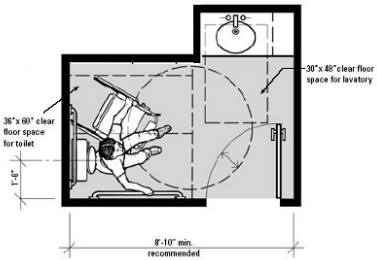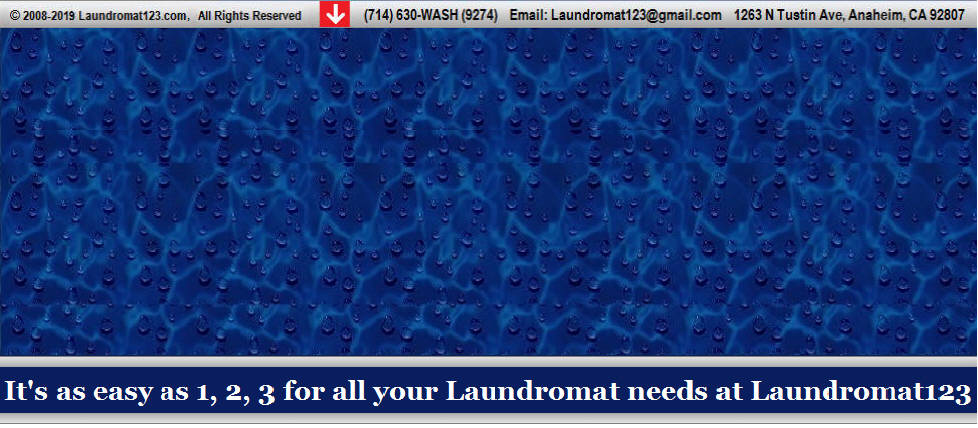YOU SHOULD KNOW ABOUT THE AMERICANS WITH DISABILITY ACT
From time to time you will read about the small business owner, including Laundromat owners, who are sued for failing to comply with the requirements of the Americans With Disabilities Act [ADA]. The time has expired for compliance and there is no "grandfather" clause in the law.
The ADA can be enforced by private citizens bringing a civil lawsuit against the business or property owner. These are some of the items that have resulted in lawsuits in the past for Laundromat owners:
1. No folding table at wheelchair height.
2. Paper towel dispensers at wrong height (in restroom and main
customer area.)
3. Mirror at wrong height.
4. Soap machine at wrong height.
5. Bill changer at wrong height (at least one has to meet handicap
access requirements.)
6. Washers and dryers at wrong height (at least one stack dryer
and one front load washer must meet access requirements.)
7. Parking lot handicap parking spaces not properly marked and
placed.
8. No sign marking the handicap parking or improperly marked.
9. P-trap under restroom sink not insulated to prevent burns to
wheelchair bound patrons.
10. Impediments to access to Laundromats, such as steps, doors
requiring too much pressure to open or ramps that are too steep.
11. Entrance and restroom doors that are too narrow.
12. Width of aisles and doors prevent wheelchair access to all areas.
13. Restroom without handicap bars or the required five foot turning area.
The following is from a survey developed by the government to assist you
in discovering compliance with the laws. You should explore current reg-
ulations on their web sites.
EDITED ADA COMPLIANCE ACCESSIBILITY GUIDELINES
(Accessibility Guidelines)
Checklist for Buildings and Facilities. This checklist has been prepared to assist individuals and entities with rights or duties under Title II, and Title III of the Americans with Disabilities Act [ADA] in applying the requirements of the Americans with Disabilities Act Accessibility Guidelines [ADAAG] to buildings and facilities subject to the law. The checklist presents information in summary form on the Department of Transportation [DOT] and the Department of Justice regulations implementing the ADA. The checklist must be used with the DOT and DOJ regulations and ADAAG to ensure accuracy.
This checklist is intended for technical assistance purposes only. Individuals who use this checklist should be aware that the Department of Justice and the Department of Transportation, not the U.S. Architectural and Transportation Barriers Compliance Board Access Board, are responsible for the enforcement of Titles II and III of the ADA. Use of this checklist does not constitute a determination of your legal rights or responsibilities under the ADA, and it is not binding on the Department of Justice, Department of Transportation, or the Access Board. Use of this checklist is voluntary. Individuals who use this checklist are not required to send the survey forms to DOJ, DOT, or the Access Board.
While ADAAG may be amended in the future, this checklist is based on ADAAG as published on July 26, 1991 [sections 1 through 4.35 and special application sections 5 through 9] and September 6, 1991 Section 10. See 56 FR 35408 [July 26, 1991] and 56 FR 45500 [September 6, 1991] as corrected at 57 FR 1393 [January 14, 1992].
MINIMUM REQUIREMENTS AND SUMMARY SHEETS
A: Parking and Passenger Loading Zones
B: Site Accessible Routes and Elements
C: Entrances
D: Building Accessible Route
E: Rooms and Spaces
F: Toilet Rooms and Bathrooms
G: Signage, Alarms, Detectable Warnings, and Automated Teller Machines [ATMs]
TECHNICAL REQUIREMENTS
[as might be found in a Laundromat]
1: Parking Survey
2: Passenger Loading Zone
3: Exterior Accessible Routes Survey
4: Curb Ramps
6: Telephones
7: Ramps
8: Stairs Survey
9: Entrances and Exits [Areas of Rescue Assistance]
10: Doors and Gates
11: Building Lobbies and Corridors [Interior Route]
12: Rooms and Space
13: Toilet Rooms
14: Signage
15: Alarms
16: Detectable Warnings
17: Automated Teller Machines [ATMs]
PURPOSE
The Americans with Disabilities Act [ADA], signed by President Bush on July 26, 1990, is landmark legislation to extend civil rights protection to people with disabilities. The ADA prohibits discrimination on the basis of disability in employment, State and local government services, public transportation, public accommodations, commercial facilities, and telecommunications. The ADA required the U.S. Architectural and Transportation Barriers Compliance Board (Access Board) to supplement its Minimum Guidelines and Requirements for Accessible Design to serve as the basis for regulations to be issued by the Department of Justice and the Department of Transportation under Title II and Title III of the Act. On July 26, 1991, the Access Board published its ADA Accessibility Guidelines for Buildings and Facilities [ADAAG]. These guidelines were amended and supplemented with provisions for transportation facilities on September 6, 1991. ADAAG is applicable to buildings and facilities covered by Title II and Title III of the ADA to the extent required by regulations issued by the Department of Justice and the Department of Transportation under the ADA.
New Construction
Places of public accommodation and commercial facilities covered by Title III of the ADA are required by 28 CFR 36.401 and 36.406 to comply with ADAAG if the facilities are designed and constructed for first occupancy after January 26, 1993. This requirement applies only if: 1)the last application for a building permit or permit extension for the facility is certified to be completed by a State, county, or local government after January 26, 1992 and 2)the first certificate of occupancy for the facility is issued after January 26, 1993. Full compliance with the new construction requirements is not required where an entity can demonstrate that it is structurally impracticable. The exception for structural impracticability, a very narrow one, is discussed in 28 CFR 36.401(c) and ADAAG 4.1.1 [5a]. Other exceptions for certain temporary structures, specific building areas and features (including elevators) are discussed in ADAAG 4.1.1 [4], 4.1.1[5b] and 4.1.3 [5] and, where applicable, on the Minimum Requirements Summary Sheets or the Technical Requirements Survey Forms.
Employee Work Areas
Areas that are used only by employees as work areas must be designed and constructed so that individuals with disabilities can approach, enter, and exit the areas as required in ADAAG 4.1.1 [3]. The guidelines do not require that any areas used only by employees as work areas be constructed to permit maneuvering within the work area or be constructed or equipped [i.e., with racks or shelves] to be accessible.
Equivalent Facilitation
Departures from the ADAAG technical and scoping provisions are permitted where the alternative designs and technologies used will provide substantially equivalent or greater access to and usability of the facility. See ADAAG 2.2 and other sections referenced in Appendix A2.2 of ADAAG for specific examples of equivalent facilitation.
Alterations
Alterations to a place of public accommodation or commercial facility covered by Title III of the ADA that are undertaken after January 26, 1992 are required by 28 CFR 36.402 and 36.406 to be done in a manner so as to ensure that, to the maximum extent feasible, the altered portions of the facility comply with ADAAG.
In general, alterations of specific elements or portions of a facility must be completed in compliance with the requirements for new construction. However, full compliance with the alterations requirements is not required where it is technically infeasible. The exception for technical infeasibility is discussed in ADAAG 4.1.6 [1 j].
If an alteration affects or could affect the usability of or access to an area of a facility that contains a "primary function," an accessible path of travel must be provided to the altered area. In addition, restrooms, telephones, and drinking fountains serving the altered area must also be made accessible to the extent that the cost is not "disproportionate" to the cost of the overall alteration. Disproportionality is defined in 28 CFR 36.403 [f] and 49 CFR 37.43 [e] as a sum not to exceed 20% of the cost of the alteration to the primary function area.
Barrier Removal in Existing Facilities
Public accommodations covered by Title III of the ADA must remove architectural barriers in existing facilities, including communication barriers that are structural in nature, where such removal is readily achievable. The ADA generally defines readily achievable as "easily accomplishable and able to be carried out without much difficulty or expense." The requirement to remove architectural barriers where readily achievable is discussed in 28 CFR 36.304. Measures taken to comply with readily achievable barrier removal must comply with ADAAG unless it would not be readily achievable. Then, other readily achievable measures that do not fully comply with ADAAG may be taken. However, no measure shall be taken that poses a significant risk to the health or safety of individuals with disabilities or others.
What Are "Places of Public Accommodation" and "Commercial Facilities"?
ADAAG applies to new construction and alterations of "places of public accommodation and commercial facilities." A "place of public accommodation" is a facility, operated by a private entity, whose operations affect commerce and which falls within at least one of the twelve categories listed below:
1. An inn, hotel, motel, or other place of lodging...
2. A restaurant, bar or other establishment...
3. A motion picture house, theater, concert hall, stadium, or place of exhibition
4. An auditorium, convention center, lecture hall...
5. A bakery, grocery store, clothing store, hardware store, shopping center...
6. A Laundromat, dry cleaner, bank, barber shop, beauty shop, travel service...
7. A terminal, depot, or other station used for specified public transportation
8. A museum, library, gallery...
9. A park, zoo, amusement park, or other place of recreation...
10. A nursery, elementary, secondary, undergraduate, postgraduate private school...
11. A day care center, senior citizen center, homeless shelter, food bank...
12. A gymnasium, health spa, bowling alley, golf course...
"Commercial facilities" are facilities whose operations will affect commerce and that are intended for nonresidential use by a private entity (e.g., factories and warehouses). "Commercial facilities" do not include facilities that are covered or expressly exempted from coverage under the Fair Housing Act of 1968, as amended; aircraft; and certain railroad equipment listed in 28 CFR 36.104.






AMERICANS WITH DISABILITIES ACT




